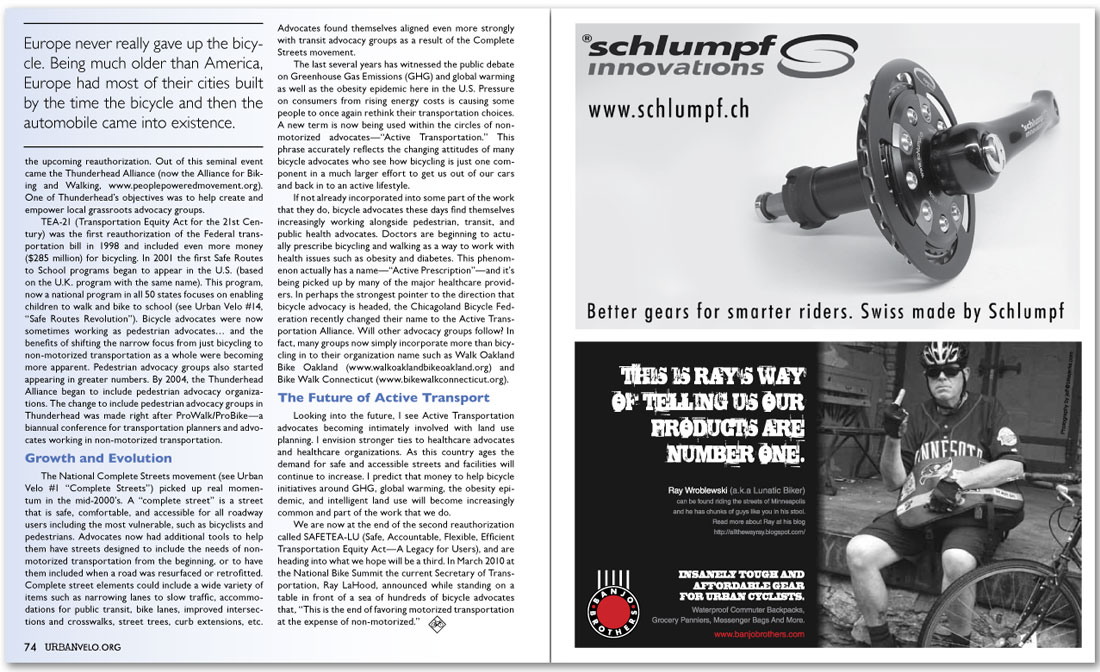


the upcoming reauthorization. Out of this seminal event came the Thunderhead Alliance (now the Alliance for Biking and Walking, www.peoplepoweredmovement.org). One of Thunderhead’s objectives was to help create and empower local grassroots advocacy groups.
TEA-21 (Transportation Equity Act for the 21st Century) was the first reauthorization of the Federal transportation bill in 1998 and included even more money ($285 million) for bicycling. In 2001 the first Safe Routes to School programs began to appear in the U.S. (based on the U.K. program with the same name). This program, now a national program in all 50 states focuses on enabling children to walk and bike to school (see Urban Velo #14, “Safe Routes Revolution”). Bicycle advocates were now sometimes working as pedestrian advocates… and the benefits of shifting the narrow focus from just bicycling to non-motorized transportation as a whole were becoming more apparent. Pedestrian advocacy groups also started appearing in greater numbers. By 2004, the Thunderhead Alliance began to include pedestrian advocacy organizations. The change to include pedestrian advocacy groups in Thunderhead was made right after ProWalk/ProBike—a biannual conference for transportation planners and advocates working in non-motorized transportation.
Growth and Evolution
The National Complete Streets movement (see Urban Velo #1 “Complete Streets”) picked up real momentum in the mid-2000’s. A “complete street” is a street that is safe, comfortable, and accessible for all roadway users including the most vulnerable, such as bicyclists and pedestrians. Advocates now had additional tools to help them have streets designed to include the needs of non-motorized transportation from the beginning, or to have them included when a road was resurfaced or retrofitted. Complete street elements could include a wide variety of items such as narrowing lanes to slow traffic, accommodations for public transit, bike lanes, improved intersections and crosswalks, street trees, curb extensions, etc. Advocates found themselves aligned even more strongly with transit advocacy groups as a result of the Complete Streets movement.
The last several years has witnessed the public debate on Greenhouse Gas Emissions (GHG) and global warming as well as the obesity epidemic here in the U.S. Pressure on consumers from rising energy costs is causing some people to once again rethink their transportation choices. A new term is now being used within the circles of non-motorized advocates—“Active Transportation.” This phrase accurately reflects the changing attitudes of many bicycle advocates who see how bicycling is just one component in a much larger effort to get us out of our cars and back in to an active lifestyle.
If not already incorporated into some part of the work that they do, bicycle advocates these days find themselves increasingly working alongside pedestrian, transit, and public health advocates. Doctors are beginning to actually prescribe bicycling and walking as a way to work with health issues such as obesity and diabetes. This phenomenon actually has a name—“Active Prescription”—and it’s being picked up by many of the major healthcare providers. In perhaps the strongest pointer to the direction that bicycle advocacy is headed, the Chicagoland Bicycle Federation recently changed their name to the Active Transportation Alliance. Will other advocacy groups follow? In fact, many groups now simply incorporate more than bicycling in to their organization name such as Walk Oakland Bike Oakland (www.walkoaklandbikeoakland.org) and Bike Walk Connecticut (www.bikewalkconnecticut.org).
The Future of Active Transport
Looking into the future, I see Active Transportation advocates becoming intimately involved with land use planning. I envision stronger ties to healthcare advocates and healthcare organizations. As this country ages the demand for safe and accessible streets and facilities will continue to increase. I predict that money to help bicycle initiatives around GHG, global warming, the obesity epidemic, and intelligent land use will become increasingly common and part of the work that we do.
We are now at the end of the second reauthorization called SAFETEA-LU (Safe, Accountable, Flexible, Efficient Transportation Equity Act—A Legacy for Users), and are heading into what we hope will be a third. In March 2010 at the National Bike Summit the current Secretary of Transportation, Ray LaHood, announced while standing on a table in front of a sea of hundreds of bicycle advocates that, “This is the end of favoring motorized transportation at the expense of non-motorized.”